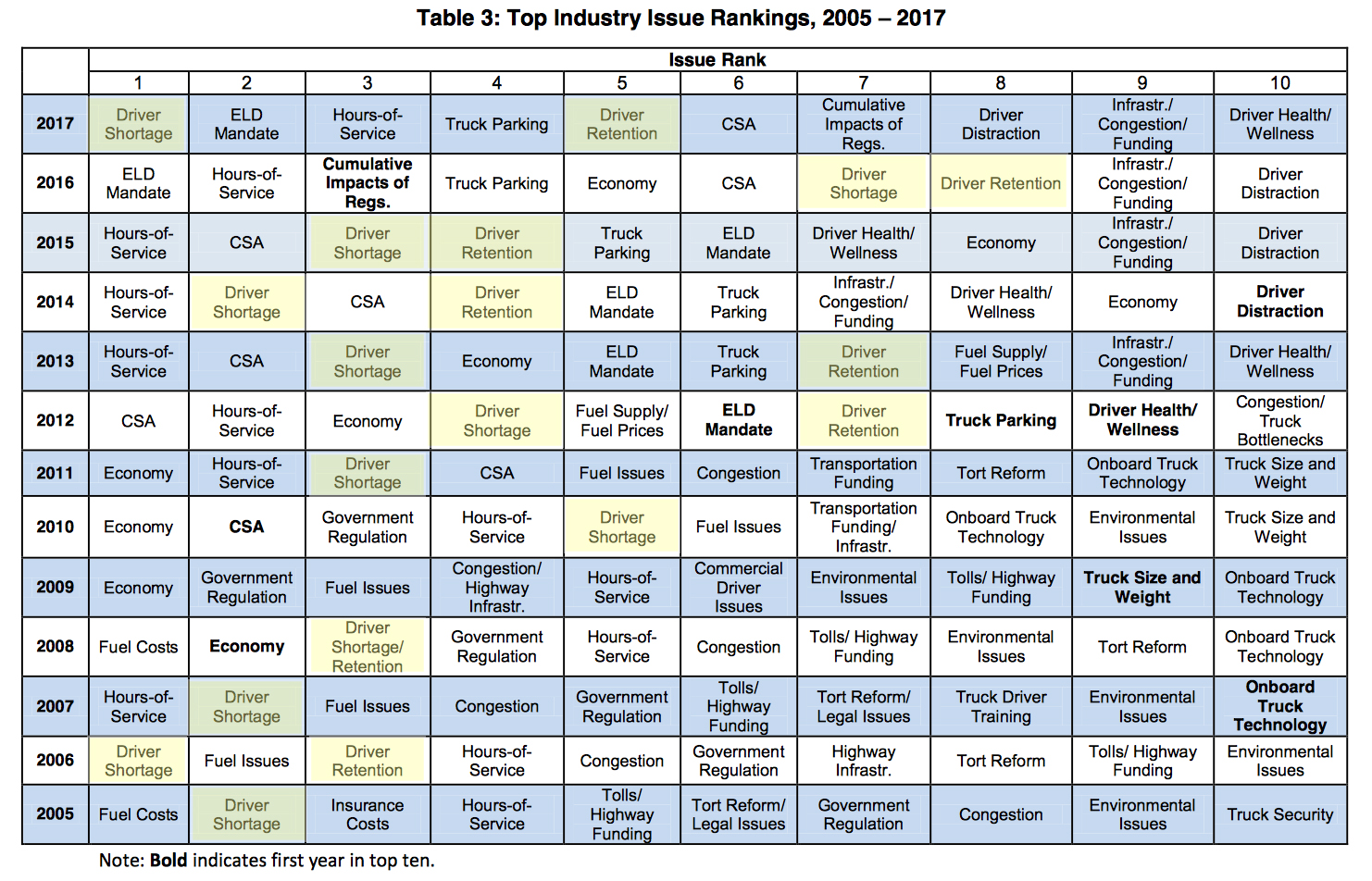
How do I Improve Driver Retention in my Trucking Fleet?
posted in Alerts by Brian Gray
How do I Improve Driver Retention in my Trucking Fleet?
For the first time ever, “Driver Shortage” is the number 1 critical issue in the trucking industry, according to ATRI’s 2017 report! Over the last 13 years, the trucking industry’s top 10 critical issues include “Driver Shortage” and “Driver Retention” 19 times (15 of which were top 5 critical issues).
- Did you know that it can cost up to $6,500 to hire each new driver?
- Did you know that 90% of driver turnover happens within the first 180 days of being hired?
- Did you know that the main reason a driver decides to quit is a perception of not being treated well by the employer?
According to the American Trucking Associations, turnover at companies has risen above 90 percent and the numbers are increasing across the industry at alarming rates.
Watch our webinar on driver retention: Meeting the Challenge of a Tight Labor Market.
Two primary reasons why drivers were choosing to leave are: Leadership/Terminal Management (11% of drivers), and Respect/Treatment: (11% of drivers).
Drivers who left also cited low levels of trust and the ineffective flow of information as reasons why they weren’t satisfied. In addition, drivers said they didn’t feel like they were heard, valued, or recognized for a job well done.
Effective communication and listening is the most important element for a driver to feel appreciated, respected and a valuable member of the team. It’s often the difference between a driver being satisfied in a job or looking for a new one.

We hear drivers constantly comment on the driver shortage: “There is a driver shortage because the industry is running off good workers and replacing those workers with substandard ones. We leave companies because of poor working conditions. Poor pay. Impossible to meet schedules. Bad management. This is 100 percent the industries fault.”
How are companies fighting driver shortage and retention?
“Some fleets mistakenly believe the economics of turnover outweigh the benefits of retention,” says Michael Fisk, director of hiring, marketing and driver development for Glendale, Ariz.-based Roadmaster Group.
If it costs around $5,000 to hire a driver – including marketing, orientation and training, for example – but it’s going to cost $15,000 a year to retain that driver, some fleets might look at those numbers “and decide it’s cheaper to lose the driver and replace him,” he says. But it’s critical that fleets look at other factors, such as safety, he cautions. “You have one accident, and it could wipe out any savings,” he says.
According to ATRI, efforts to fix the problem should be to study the effectiveness of carrier retention programs that financially incentivize drivers for driving performance in the areas of safety, fuel economy, and trip productivity. Basically, research on the relationship between driver compensation models and driver productivity.
To combat driver churn, which dramatically increases recruitment and training costs, motor carriers have begun to compete with one another using sign-on/stay-on bonuses.
ATRI estimated that motor carriers paid drivers an average of $1,500 in safety bonuses in 2016. While ATRI understands that driver pay is only part of the equation, it appears to play a leading role in maintaining and/or enhancing driver satisfaction.
The problem for small motor carriers of 5 to 25 drivers, which make up around 90%+ of the trucking industry, is they cannot afford to offer safety bonuses, or cannot compete with larger fleet’s compensation. So, what can these smaller companies do?
According to ATRI, they want to create an online collection of retention strategies and best practices, customizable by carrier fleet size and sector. Once research into the effectiveness of carrier retention programs and compensation models has been completed, it will be important to establish a centralized repository for this information to facilitate the ultimate adoption of the best retention strategies and practices.
What should this list include for smaller fleets?
We believe in three simple Driver Retention programs:
- Effective Listening and Communication for new drivers
- Exit Interviews
- Employee Satisfaction Surveys
Effective communication and listening is the most important element for a driver to feel appreciated, respected and a valuable member of the team. It’s often the difference between a driver being content in a job or looking for a new one. The most important touch points with new drivers is over their first 180 days that includes: 14, 30, 60, 90, 120, and 180 day wellness check calls.
Exit interviews fit into the separation stage of employees. This stage spans from the moment an employee becomes disengaged until their departure from the organization. An off-boarding process allows both the employer and employee to properly close the existing relationship so that company materials are collected, administrative forms are completed, knowledge base and projects are transferred or documented, feedback and insights are gathered through exit interviews, and any loose ends are resolved.
Finding out what the issues are is the first step to step to solving them. An Employee Satisfaction Survey offers a method to collect and analyze information from your most important asset, your employees. Survey data can uncover ordinarily hidden information that can help improve your company.
See what other Carries and Drivers are doing or wanting:
- Practical mileage, better pay, offer incentives for those who work hard, provide safe and comfortable equipment, and FRIENDLY FACES IN THE OFFICE!
- Hiring a driver and sending them over the road without training them it’s like hiring an uneducated chef to cook in a restaurant. Drivers are great at driving but the majority don’t know how the transportation business really works. They just go for what other drivers tell them to do. Period.
- A general rule of business, most people don’t quit jobs, they quit bosses.
- We run 190 trucks and have a 20% turnover rate (industry avg over 100%).
- We care about our drivers. They are not a number…we know their names, their kid’s names…we are always happy to see them. If they have troubles of a personal or professional nature, we do our best to help them. Our CEO cherishes the opportunity to minister to them and has an open door policy where any of the drivers can come in and sit down and talk with him
- Do what you say you are going to do.
- Give them options…account-wise and fleet-wise.
- Get them home
- Don’t screw up their paychecks
- Be loyal to them and they will be loyal to you.
- Offer a good benefits package.
Our pay rate is below average (unless you consider the entire package with benefits, then we are above average)…but we do all of the above and do a great job of keeping our drivers






